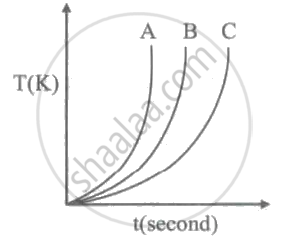Advertisements
Advertisements
प्रश्न
The cold object the hot object enclosed in one box of heat-resistant material.
- What changes will occur in the two objects when temperature flows from those objects?
- Which principle can show that the energy exchange takes place between two objects only when kept in isolated system?
उत्तर
1. Temperature of cold object increases due to gain of heat energy.
2. At the same time, temperature of hot object decreases due to loss of heat energy.
3. The process of heat exchange continues till both the objects acquire the same temperature.- Principle of heat exchange can show that the energy exchange takes place between two objects only when kept in isolated system.
APPEARS IN
संबंधित प्रश्न
In an experiment on the specific heat of a metal, a 0.20 kg block of the metal at 150 °C is dropped in a copper calorimeter (of water equivalent 0.025 kg) containing 150 cm3 of water at 27 °C. The final temperature is 40 °C. Compute the specific heat of the metal. If heat losses to the surroundings are not negligible, is your answer greater or smaller than the actual value for the specific heat of the metal?
Find the time taken by a 500 W heater to raise the temperature of 50 kg of material of specific heat capacity 960 J kg-1K-1, from 18°C to 38° C. Assume that all the heat energy supplied by the heater is given to the material.
State the effect of enhancement of green house effect.
How will climate changes affect the various animal species?
Without green house effect, the average temperature of earth’s surface would have been:
(a) – 18℃
(b) 33℃
(c) 0℃
(d) 15℃
A calorimeter has mass 100 g and specific heat 0.1 kcal/ kg °C. It contains 250 gm of liquid at 30°C having specific heat of 0.4 kcal/kg °C. If we drop a piece of ice of mass 10 g at 0°C, What will be the temperature of the mixture?
A burner raises the temperature of 360 g of water from 40°C to 100°C in 5 minutes. Calculate the rate of heat supplied by the burner.
If 10125 J of heat energy boils off 4.5 g of water at 100°C to steam at 100°C, find the specific latent heat of steam.
A liquid X has specific heat capacity higher than the liquid Y. Which liquid is useful as heat reservoir to keep juice bottles without freezing?
Does the specific heat capacity of a substance depend upon its mass and rise in temperature only?
Write the approximate values of the specific latent heat of fusion of ice.
Why is specific heat capacity taken as a measure of thermal inertia?
A certain amount of heat Q will warm 1 g of material X by 3°C and 1 g of material Y by 4°C. Which material has a higher specific heat capacity?
Why are athletes advised to put on extra clothes after competing on event?
Calculate the ratio of two specific heats of polyatomic gas molecules.
50 g of copper is heated to increase its temperature by 10° C. If the same quantity of heat is given to 5 g water, the rise in its temperature is [Specific heat of copper = 420 joule-kg-1 °C-1 , specific heat of water = 4200 joule-kg-I °C-1]
Which of the following substances (A, B and C) has the highest specific beat?

Water has the lowest specific heat capacity.
Match the columns:
| Column ‘A’ | Column ‘B’ |
| The SI unit of specific heat capacity | (a) Jkg−1°C−1 |
| (b) kg/m3 | |
| (c) calorie |
Find the odd one out:
